MNCs, Culture, and Regulation: Exploiting Differences in Global Market
VerifiedAdded on 2023/04/06
|14
|3485
|138
Essay
AI Summary
This essay examines how multinational companies (MNCs) like Walmart exploit national and regional differences in culture and regulation to gain competitive advantages in international business. It discusses the importance of location advantages, such as strategic positioning and access to trade blocs, for different types of inward investments, including foreign institutional investments and direct investments. The essay also explores how regional differences in consumer preferences influence product strategies and internal policies of MNCs. Furthermore, it analyzes the role of government regulations in shaping investment decisions and the extent to which MNCs can standardize their operations versus adapt to local market conditions. The analysis uses examples such as Walmart's operations in Turkey, Singapore, India, and Mexico, as well as comparisons with companies like Google and Apple, to illustrate the complexities of international business strategy. Desklib provides a platform for students to access similar essays and solved assignments for further study.
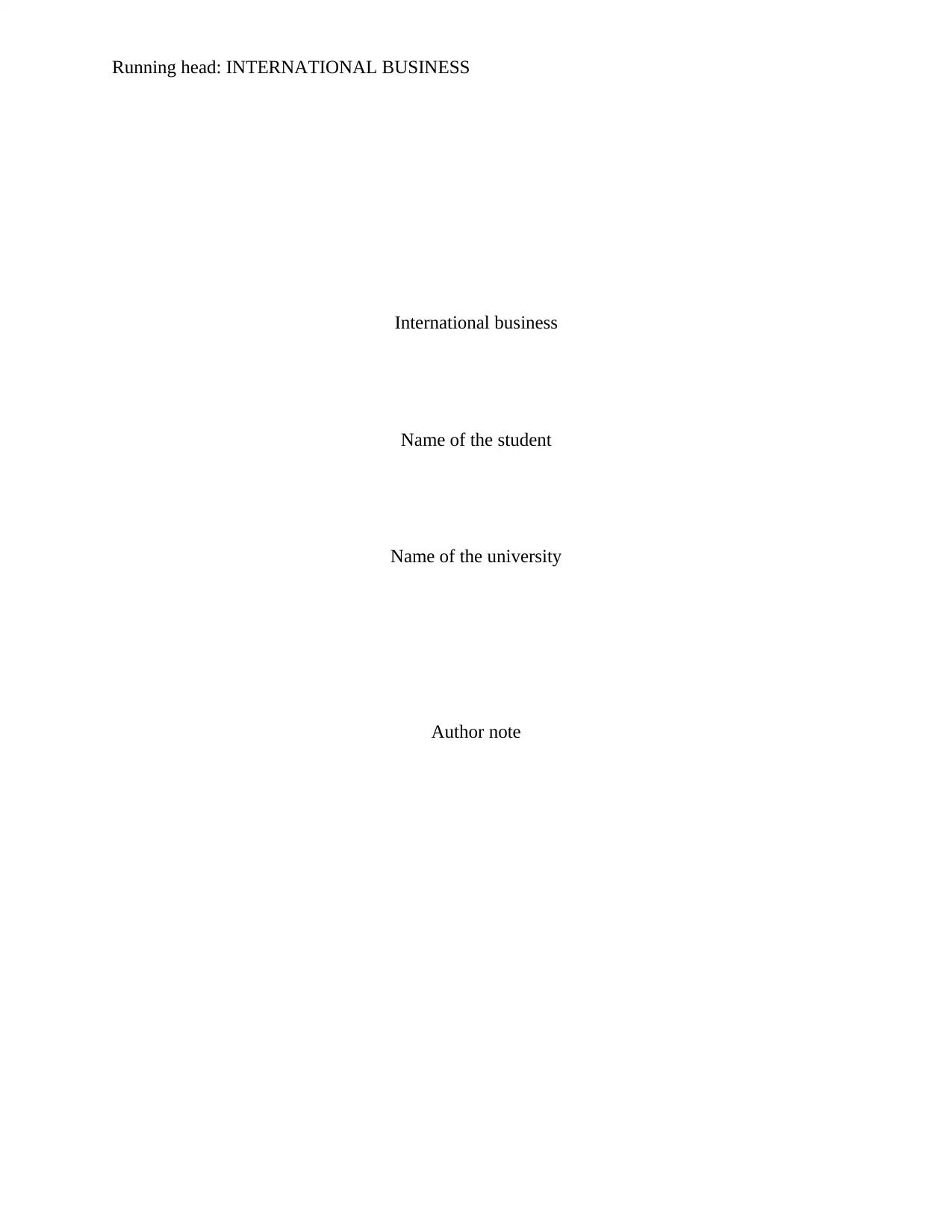
Running head: INTERNATIONAL BUSINESS
International business
Name of the student
Name of the university
Author note
International business
Name of the student
Name of the university
Author note
Paraphrase This Document
Need a fresh take? Get an instant paraphrase of this document with our AI Paraphraser
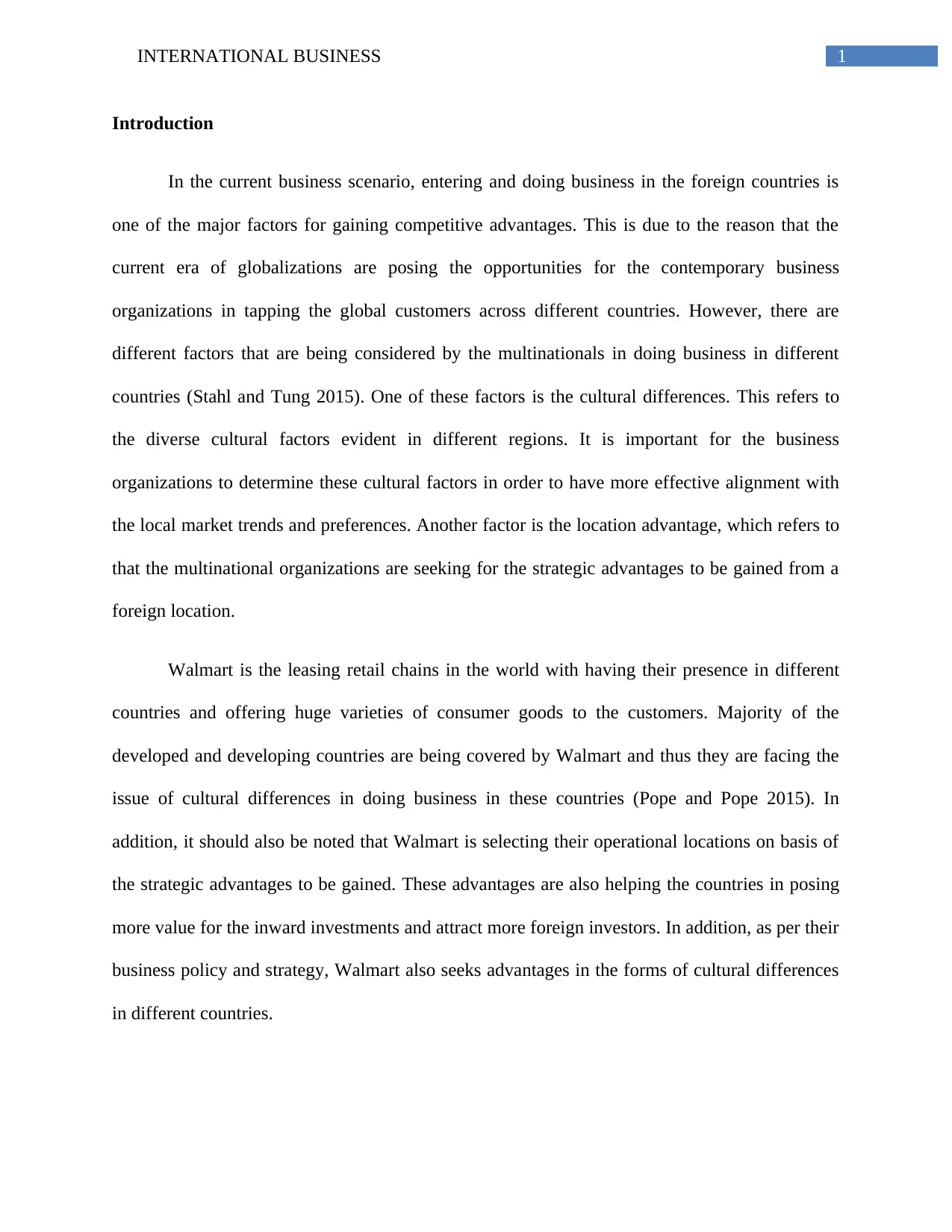
1INTERNATIONAL BUSINESS
Introduction
In the current business scenario, entering and doing business in the foreign countries is
one of the major factors for gaining competitive advantages. This is due to the reason that the
current era of globalizations are posing the opportunities for the contemporary business
organizations in tapping the global customers across different countries. However, there are
different factors that are being considered by the multinationals in doing business in different
countries (Stahl and Tung 2015). One of these factors is the cultural differences. This refers to
the diverse cultural factors evident in different regions. It is important for the business
organizations to determine these cultural factors in order to have more effective alignment with
the local market trends and preferences. Another factor is the location advantage, which refers to
that the multinational organizations are seeking for the strategic advantages to be gained from a
foreign location.
Walmart is the leasing retail chains in the world with having their presence in different
countries and offering huge varieties of consumer goods to the customers. Majority of the
developed and developing countries are being covered by Walmart and thus they are facing the
issue of cultural differences in doing business in these countries (Pope and Pope 2015). In
addition, it should also be noted that Walmart is selecting their operational locations on basis of
the strategic advantages to be gained. These advantages are also helping the countries in posing
more value for the inward investments and attract more foreign investors. In addition, as per their
business policy and strategy, Walmart also seeks advantages in the forms of cultural differences
in different countries.
Introduction
In the current business scenario, entering and doing business in the foreign countries is
one of the major factors for gaining competitive advantages. This is due to the reason that the
current era of globalizations are posing the opportunities for the contemporary business
organizations in tapping the global customers across different countries. However, there are
different factors that are being considered by the multinationals in doing business in different
countries (Stahl and Tung 2015). One of these factors is the cultural differences. This refers to
the diverse cultural factors evident in different regions. It is important for the business
organizations to determine these cultural factors in order to have more effective alignment with
the local market trends and preferences. Another factor is the location advantage, which refers to
that the multinational organizations are seeking for the strategic advantages to be gained from a
foreign location.
Walmart is the leasing retail chains in the world with having their presence in different
countries and offering huge varieties of consumer goods to the customers. Majority of the
developed and developing countries are being covered by Walmart and thus they are facing the
issue of cultural differences in doing business in these countries (Pope and Pope 2015). In
addition, it should also be noted that Walmart is selecting their operational locations on basis of
the strategic advantages to be gained. These advantages are also helping the countries in posing
more value for the inward investments and attract more foreign investors. In addition, as per their
business policy and strategy, Walmart also seeks advantages in the forms of cultural differences
in different countries.
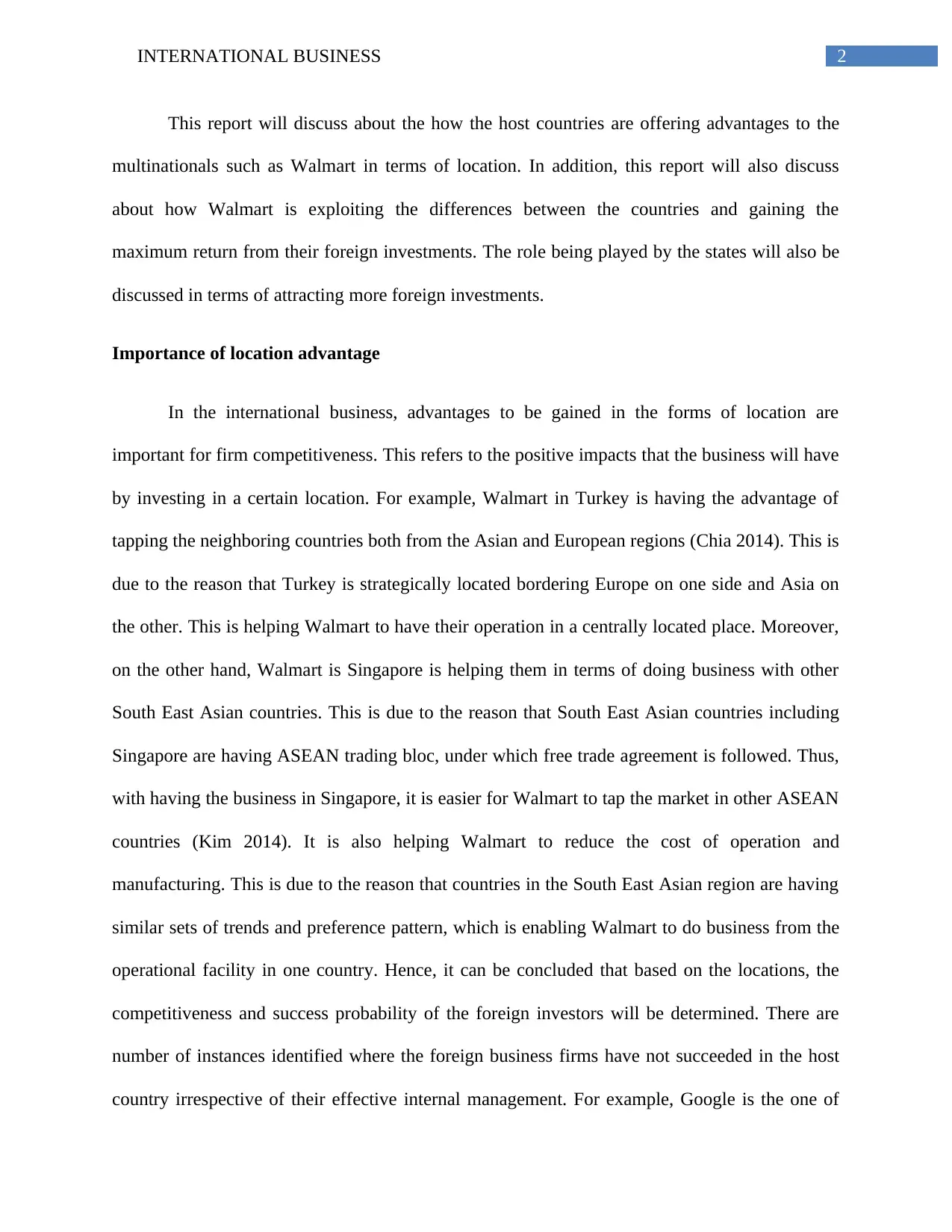
2INTERNATIONAL BUSINESS
This report will discuss about the how the host countries are offering advantages to the
multinationals such as Walmart in terms of location. In addition, this report will also discuss
about how Walmart is exploiting the differences between the countries and gaining the
maximum return from their foreign investments. The role being played by the states will also be
discussed in terms of attracting more foreign investments.
Importance of location advantage
In the international business, advantages to be gained in the forms of location are
important for firm competitiveness. This refers to the positive impacts that the business will have
by investing in a certain location. For example, Walmart in Turkey is having the advantage of
tapping the neighboring countries both from the Asian and European regions (Chia 2014). This is
due to the reason that Turkey is strategically located bordering Europe on one side and Asia on
the other. This is helping Walmart to have their operation in a centrally located place. Moreover,
on the other hand, Walmart is Singapore is helping them in terms of doing business with other
South East Asian countries. This is due to the reason that South East Asian countries including
Singapore are having ASEAN trading bloc, under which free trade agreement is followed. Thus,
with having the business in Singapore, it is easier for Walmart to tap the market in other ASEAN
countries (Kim 2014). It is also helping Walmart to reduce the cost of operation and
manufacturing. This is due to the reason that countries in the South East Asian region are having
similar sets of trends and preference pattern, which is enabling Walmart to do business from the
operational facility in one country. Hence, it can be concluded that based on the locations, the
competitiveness and success probability of the foreign investors will be determined. There are
number of instances identified where the foreign business firms have not succeeded in the host
country irrespective of their effective internal management. For example, Google is the one of
This report will discuss about the how the host countries are offering advantages to the
multinationals such as Walmart in terms of location. In addition, this report will also discuss
about how Walmart is exploiting the differences between the countries and gaining the
maximum return from their foreign investments. The role being played by the states will also be
discussed in terms of attracting more foreign investments.
Importance of location advantage
In the international business, advantages to be gained in the forms of location are
important for firm competitiveness. This refers to the positive impacts that the business will have
by investing in a certain location. For example, Walmart in Turkey is having the advantage of
tapping the neighboring countries both from the Asian and European regions (Chia 2014). This is
due to the reason that Turkey is strategically located bordering Europe on one side and Asia on
the other. This is helping Walmart to have their operation in a centrally located place. Moreover,
on the other hand, Walmart is Singapore is helping them in terms of doing business with other
South East Asian countries. This is due to the reason that South East Asian countries including
Singapore are having ASEAN trading bloc, under which free trade agreement is followed. Thus,
with having the business in Singapore, it is easier for Walmart to tap the market in other ASEAN
countries (Kim 2014). It is also helping Walmart to reduce the cost of operation and
manufacturing. This is due to the reason that countries in the South East Asian region are having
similar sets of trends and preference pattern, which is enabling Walmart to do business from the
operational facility in one country. Hence, it can be concluded that based on the locations, the
competitiveness and success probability of the foreign investors will be determined. There are
number of instances identified where the foreign business firms have not succeeded in the host
country irrespective of their effective internal management. For example, Google is the one of
⊘ This is a preview!⊘
Do you want full access?
Subscribe today to unlock all pages.

Trusted by 1+ million students worldwide
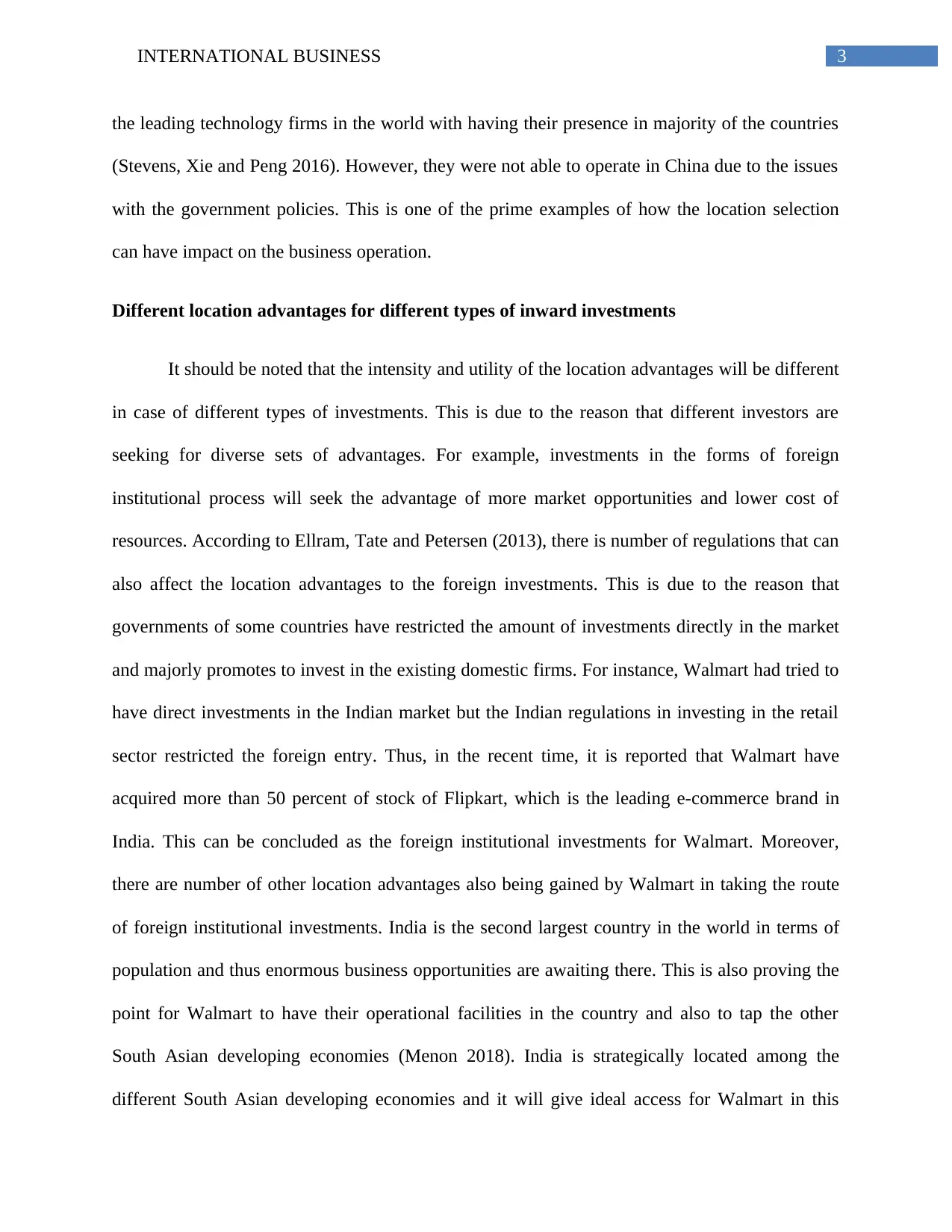
3INTERNATIONAL BUSINESS
the leading technology firms in the world with having their presence in majority of the countries
(Stevens, Xie and Peng 2016). However, they were not able to operate in China due to the issues
with the government policies. This is one of the prime examples of how the location selection
can have impact on the business operation.
Different location advantages for different types of inward investments
It should be noted that the intensity and utility of the location advantages will be different
in case of different types of investments. This is due to the reason that different investors are
seeking for diverse sets of advantages. For example, investments in the forms of foreign
institutional process will seek the advantage of more market opportunities and lower cost of
resources. According to Ellram, Tate and Petersen (2013), there is number of regulations that can
also affect the location advantages to the foreign investments. This is due to the reason that
governments of some countries have restricted the amount of investments directly in the market
and majorly promotes to invest in the existing domestic firms. For instance, Walmart had tried to
have direct investments in the Indian market but the Indian regulations in investing in the retail
sector restricted the foreign entry. Thus, in the recent time, it is reported that Walmart have
acquired more than 50 percent of stock of Flipkart, which is the leading e-commerce brand in
India. This can be concluded as the foreign institutional investments for Walmart. Moreover,
there are number of other location advantages also being gained by Walmart in taking the route
of foreign institutional investments. India is the second largest country in the world in terms of
population and thus enormous business opportunities are awaiting there. This is also proving the
point for Walmart to have their operational facilities in the country and also to tap the other
South Asian developing economies (Menon 2018). India is strategically located among the
different South Asian developing economies and it will give ideal access for Walmart in this
the leading technology firms in the world with having their presence in majority of the countries
(Stevens, Xie and Peng 2016). However, they were not able to operate in China due to the issues
with the government policies. This is one of the prime examples of how the location selection
can have impact on the business operation.
Different location advantages for different types of inward investments
It should be noted that the intensity and utility of the location advantages will be different
in case of different types of investments. This is due to the reason that different investors are
seeking for diverse sets of advantages. For example, investments in the forms of foreign
institutional process will seek the advantage of more market opportunities and lower cost of
resources. According to Ellram, Tate and Petersen (2013), there is number of regulations that can
also affect the location advantages to the foreign investments. This is due to the reason that
governments of some countries have restricted the amount of investments directly in the market
and majorly promotes to invest in the existing domestic firms. For instance, Walmart had tried to
have direct investments in the Indian market but the Indian regulations in investing in the retail
sector restricted the foreign entry. Thus, in the recent time, it is reported that Walmart have
acquired more than 50 percent of stock of Flipkart, which is the leading e-commerce brand in
India. This can be concluded as the foreign institutional investments for Walmart. Moreover,
there are number of other location advantages also being gained by Walmart in taking the route
of foreign institutional investments. India is the second largest country in the world in terms of
population and thus enormous business opportunities are awaiting there. This is also proving the
point for Walmart to have their operational facilities in the country and also to tap the other
South Asian developing economies (Menon 2018). India is strategically located among the
different South Asian developing economies and it will give ideal access for Walmart in this
Paraphrase This Document
Need a fresh take? Get an instant paraphrase of this document with our AI Paraphraser
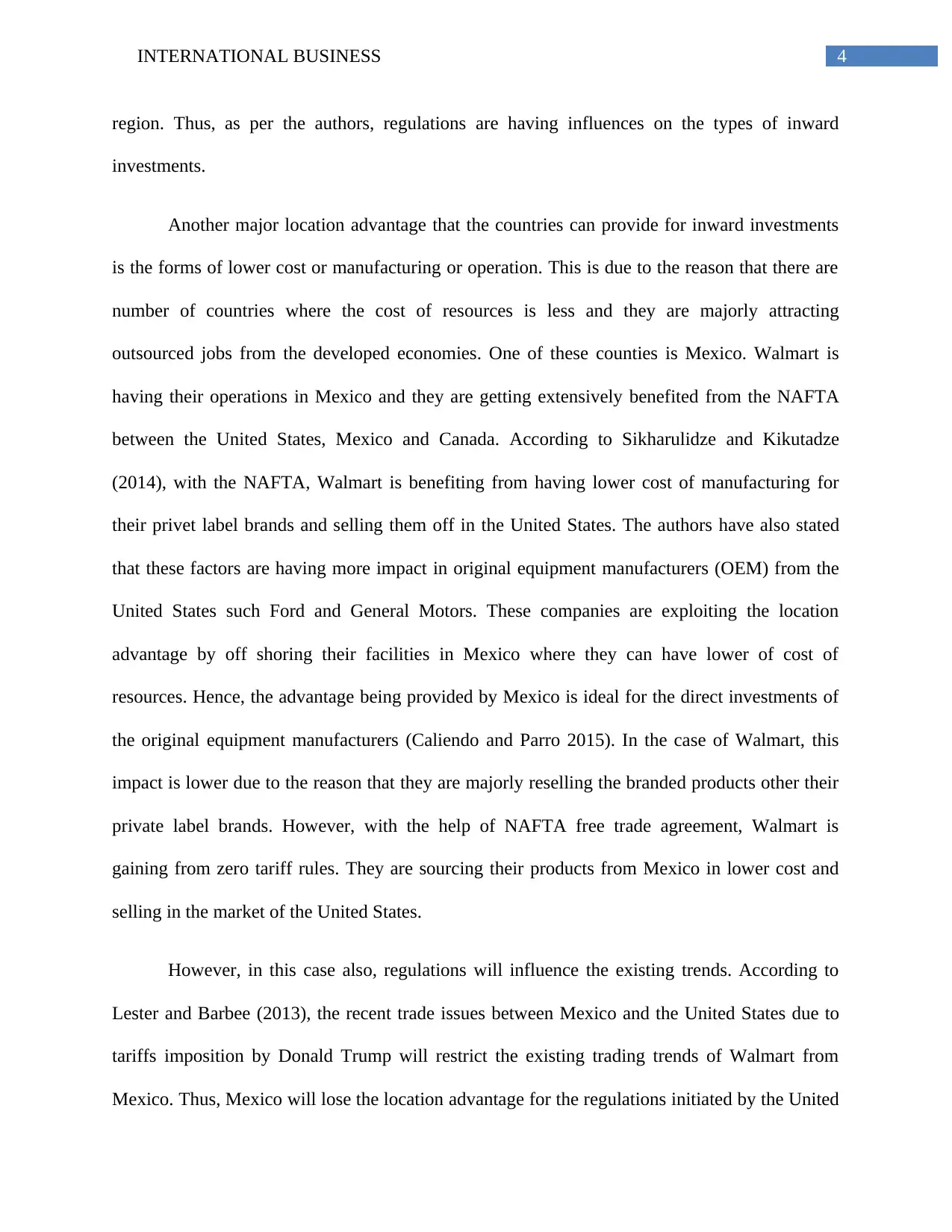
4INTERNATIONAL BUSINESS
region. Thus, as per the authors, regulations are having influences on the types of inward
investments.
Another major location advantage that the countries can provide for inward investments
is the forms of lower cost or manufacturing or operation. This is due to the reason that there are
number of countries where the cost of resources is less and they are majorly attracting
outsourced jobs from the developed economies. One of these counties is Mexico. Walmart is
having their operations in Mexico and they are getting extensively benefited from the NAFTA
between the United States, Mexico and Canada. According to Sikharulidze and Kikutadze
(2014), with the NAFTA, Walmart is benefiting from having lower cost of manufacturing for
their privet label brands and selling them off in the United States. The authors have also stated
that these factors are having more impact in original equipment manufacturers (OEM) from the
United States such Ford and General Motors. These companies are exploiting the location
advantage by off shoring their facilities in Mexico where they can have lower of cost of
resources. Hence, the advantage being provided by Mexico is ideal for the direct investments of
the original equipment manufacturers (Caliendo and Parro 2015). In the case of Walmart, this
impact is lower due to the reason that they are majorly reselling the branded products other their
private label brands. However, with the help of NAFTA free trade agreement, Walmart is
gaining from zero tariff rules. They are sourcing their products from Mexico in lower cost and
selling in the market of the United States.
However, in this case also, regulations will influence the existing trends. According to
Lester and Barbee (2013), the recent trade issues between Mexico and the United States due to
tariffs imposition by Donald Trump will restrict the existing trading trends of Walmart from
Mexico. Thus, Mexico will lose the location advantage for the regulations initiated by the United
region. Thus, as per the authors, regulations are having influences on the types of inward
investments.
Another major location advantage that the countries can provide for inward investments
is the forms of lower cost or manufacturing or operation. This is due to the reason that there are
number of countries where the cost of resources is less and they are majorly attracting
outsourced jobs from the developed economies. One of these counties is Mexico. Walmart is
having their operations in Mexico and they are getting extensively benefited from the NAFTA
between the United States, Mexico and Canada. According to Sikharulidze and Kikutadze
(2014), with the NAFTA, Walmart is benefiting from having lower cost of manufacturing for
their privet label brands and selling them off in the United States. The authors have also stated
that these factors are having more impact in original equipment manufacturers (OEM) from the
United States such Ford and General Motors. These companies are exploiting the location
advantage by off shoring their facilities in Mexico where they can have lower of cost of
resources. Hence, the advantage being provided by Mexico is ideal for the direct investments of
the original equipment manufacturers (Caliendo and Parro 2015). In the case of Walmart, this
impact is lower due to the reason that they are majorly reselling the branded products other their
private label brands. However, with the help of NAFTA free trade agreement, Walmart is
gaining from zero tariff rules. They are sourcing their products from Mexico in lower cost and
selling in the market of the United States.
However, in this case also, regulations will influence the existing trends. According to
Lester and Barbee (2013), the recent trade issues between Mexico and the United States due to
tariffs imposition by Donald Trump will restrict the existing trading trends of Walmart from
Mexico. Thus, Mexico will lose the location advantage for the regulations initiated by the United
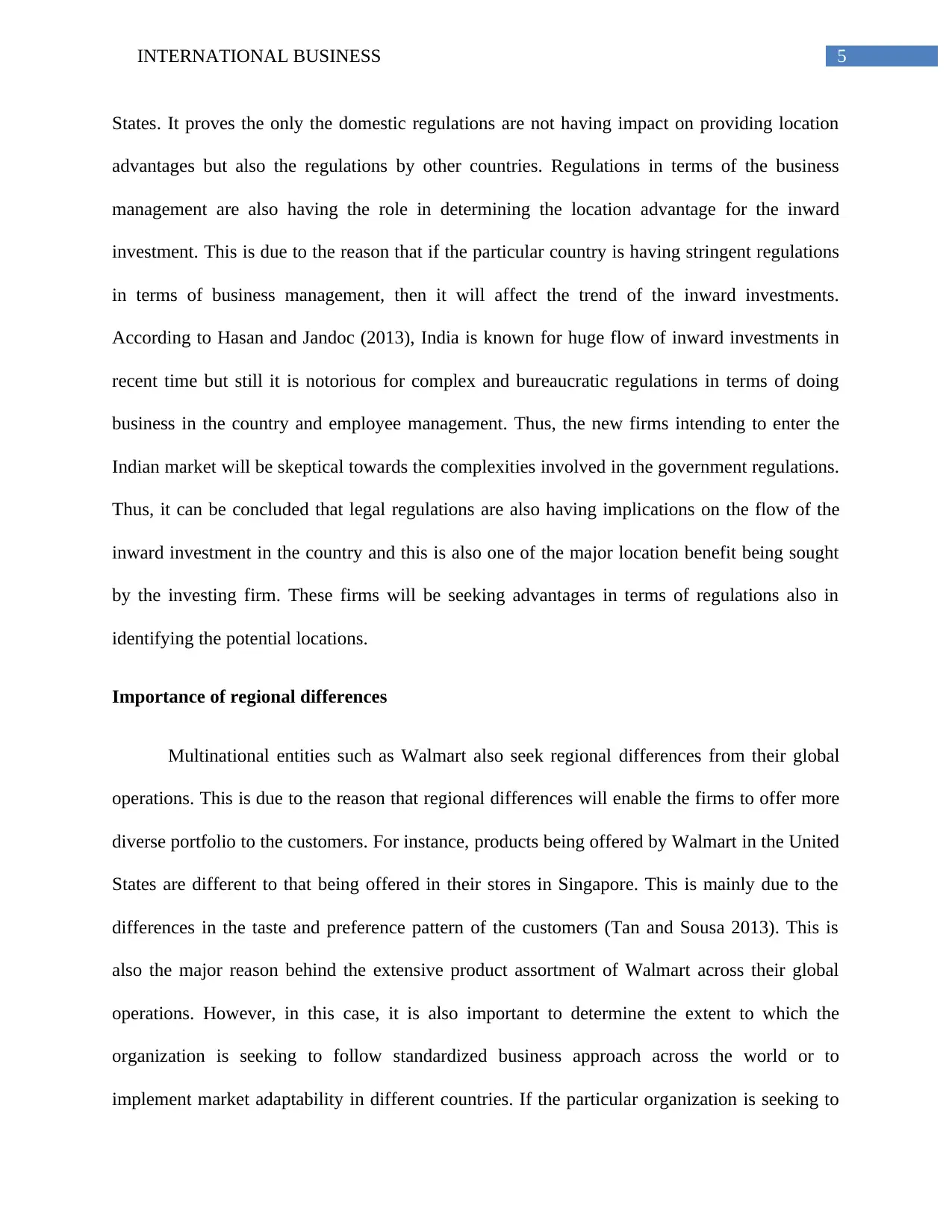
5INTERNATIONAL BUSINESS
States. It proves the only the domestic regulations are not having impact on providing location
advantages but also the regulations by other countries. Regulations in terms of the business
management are also having the role in determining the location advantage for the inward
investment. This is due to the reason that if the particular country is having stringent regulations
in terms of business management, then it will affect the trend of the inward investments.
According to Hasan and Jandoc (2013), India is known for huge flow of inward investments in
recent time but still it is notorious for complex and bureaucratic regulations in terms of doing
business in the country and employee management. Thus, the new firms intending to enter the
Indian market will be skeptical towards the complexities involved in the government regulations.
Thus, it can be concluded that legal regulations are also having implications on the flow of the
inward investment in the country and this is also one of the major location benefit being sought
by the investing firm. These firms will be seeking advantages in terms of regulations also in
identifying the potential locations.
Importance of regional differences
Multinational entities such as Walmart also seek regional differences from their global
operations. This is due to the reason that regional differences will enable the firms to offer more
diverse portfolio to the customers. For instance, products being offered by Walmart in the United
States are different to that being offered in their stores in Singapore. This is mainly due to the
differences in the taste and preference pattern of the customers (Tan and Sousa 2013). This is
also the major reason behind the extensive product assortment of Walmart across their global
operations. However, in this case, it is also important to determine the extent to which the
organization is seeking to follow standardized business approach across the world or to
implement market adaptability in different countries. If the particular organization is seeking to
States. It proves the only the domestic regulations are not having impact on providing location
advantages but also the regulations by other countries. Regulations in terms of the business
management are also having the role in determining the location advantage for the inward
investment. This is due to the reason that if the particular country is having stringent regulations
in terms of business management, then it will affect the trend of the inward investments.
According to Hasan and Jandoc (2013), India is known for huge flow of inward investments in
recent time but still it is notorious for complex and bureaucratic regulations in terms of doing
business in the country and employee management. Thus, the new firms intending to enter the
Indian market will be skeptical towards the complexities involved in the government regulations.
Thus, it can be concluded that legal regulations are also having implications on the flow of the
inward investment in the country and this is also one of the major location benefit being sought
by the investing firm. These firms will be seeking advantages in terms of regulations also in
identifying the potential locations.
Importance of regional differences
Multinational entities such as Walmart also seek regional differences from their global
operations. This is due to the reason that regional differences will enable the firms to offer more
diverse portfolio to the customers. For instance, products being offered by Walmart in the United
States are different to that being offered in their stores in Singapore. This is mainly due to the
differences in the taste and preference pattern of the customers (Tan and Sousa 2013). This is
also the major reason behind the extensive product assortment of Walmart across their global
operations. However, in this case, it is also important to determine the extent to which the
organization is seeking to follow standardized business approach across the world or to
implement market adaptability in different countries. If the particular organization is seeking to
⊘ This is a preview!⊘
Do you want full access?
Subscribe today to unlock all pages.

Trusted by 1+ million students worldwide
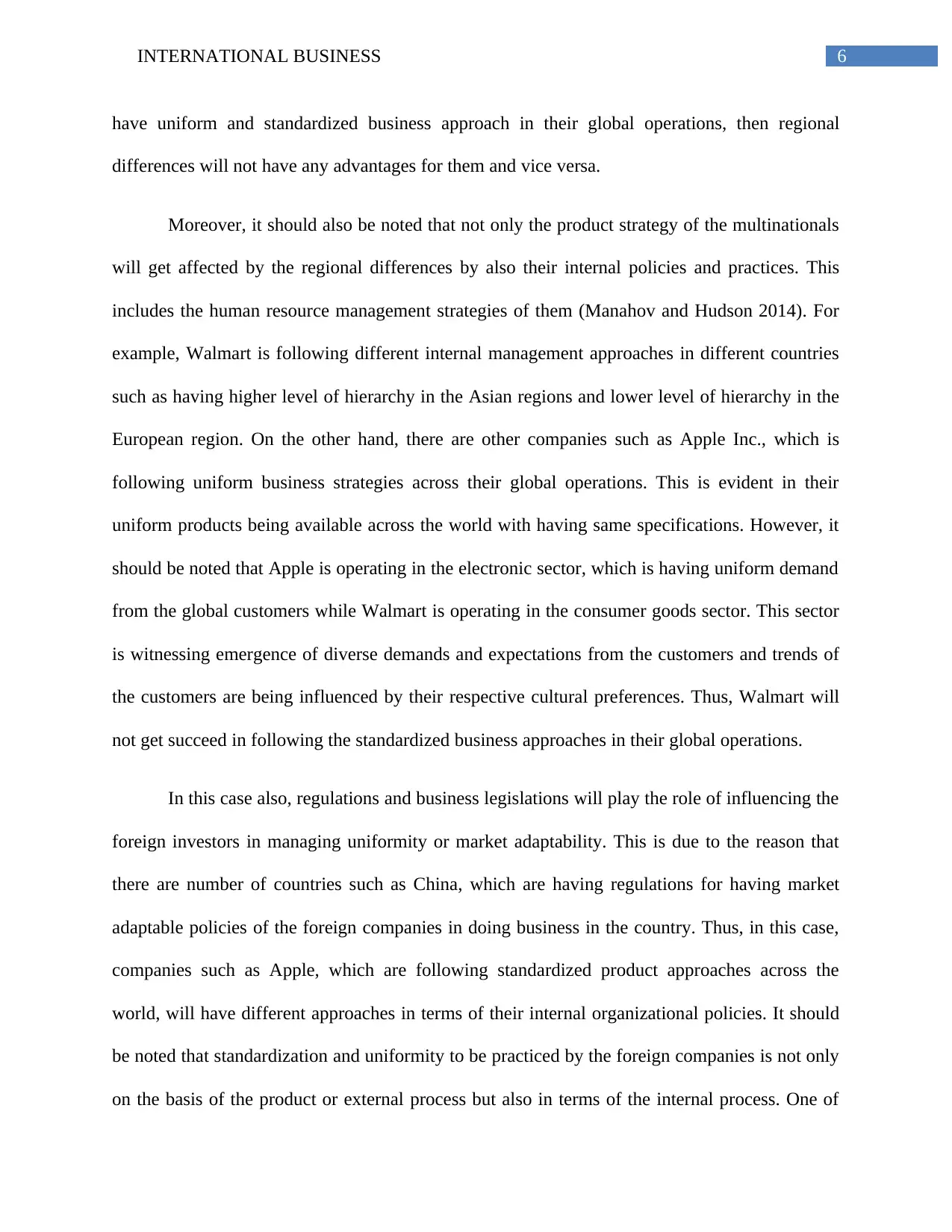
6INTERNATIONAL BUSINESS
have uniform and standardized business approach in their global operations, then regional
differences will not have any advantages for them and vice versa.
Moreover, it should also be noted that not only the product strategy of the multinationals
will get affected by the regional differences by also their internal policies and practices. This
includes the human resource management strategies of them (Manahov and Hudson 2014). For
example, Walmart is following different internal management approaches in different countries
such as having higher level of hierarchy in the Asian regions and lower level of hierarchy in the
European region. On the other hand, there are other companies such as Apple Inc., which is
following uniform business strategies across their global operations. This is evident in their
uniform products being available across the world with having same specifications. However, it
should be noted that Apple is operating in the electronic sector, which is having uniform demand
from the global customers while Walmart is operating in the consumer goods sector. This sector
is witnessing emergence of diverse demands and expectations from the customers and trends of
the customers are being influenced by their respective cultural preferences. Thus, Walmart will
not get succeed in following the standardized business approaches in their global operations.
In this case also, regulations and business legislations will play the role of influencing the
foreign investors in managing uniformity or market adaptability. This is due to the reason that
there are number of countries such as China, which are having regulations for having market
adaptable policies of the foreign companies in doing business in the country. Thus, in this case,
companies such as Apple, which are following standardized product approaches across the
world, will have different approaches in terms of their internal organizational policies. It should
be noted that standardization and uniformity to be practiced by the foreign companies is not only
on the basis of the product or external process but also in terms of the internal process. One of
have uniform and standardized business approach in their global operations, then regional
differences will not have any advantages for them and vice versa.
Moreover, it should also be noted that not only the product strategy of the multinationals
will get affected by the regional differences by also their internal policies and practices. This
includes the human resource management strategies of them (Manahov and Hudson 2014). For
example, Walmart is following different internal management approaches in different countries
such as having higher level of hierarchy in the Asian regions and lower level of hierarchy in the
European region. On the other hand, there are other companies such as Apple Inc., which is
following uniform business strategies across their global operations. This is evident in their
uniform products being available across the world with having same specifications. However, it
should be noted that Apple is operating in the electronic sector, which is having uniform demand
from the global customers while Walmart is operating in the consumer goods sector. This sector
is witnessing emergence of diverse demands and expectations from the customers and trends of
the customers are being influenced by their respective cultural preferences. Thus, Walmart will
not get succeed in following the standardized business approaches in their global operations.
In this case also, regulations and business legislations will play the role of influencing the
foreign investors in managing uniformity or market adaptability. This is due to the reason that
there are number of countries such as China, which are having regulations for having market
adaptable policies of the foreign companies in doing business in the country. Thus, in this case,
companies such as Apple, which are following standardized product approaches across the
world, will have different approaches in terms of their internal organizational policies. It should
be noted that standardization and uniformity to be practiced by the foreign companies is not only
on the basis of the product or external process but also in terms of the internal process. One of
Paraphrase This Document
Need a fresh take? Get an instant paraphrase of this document with our AI Paraphraser
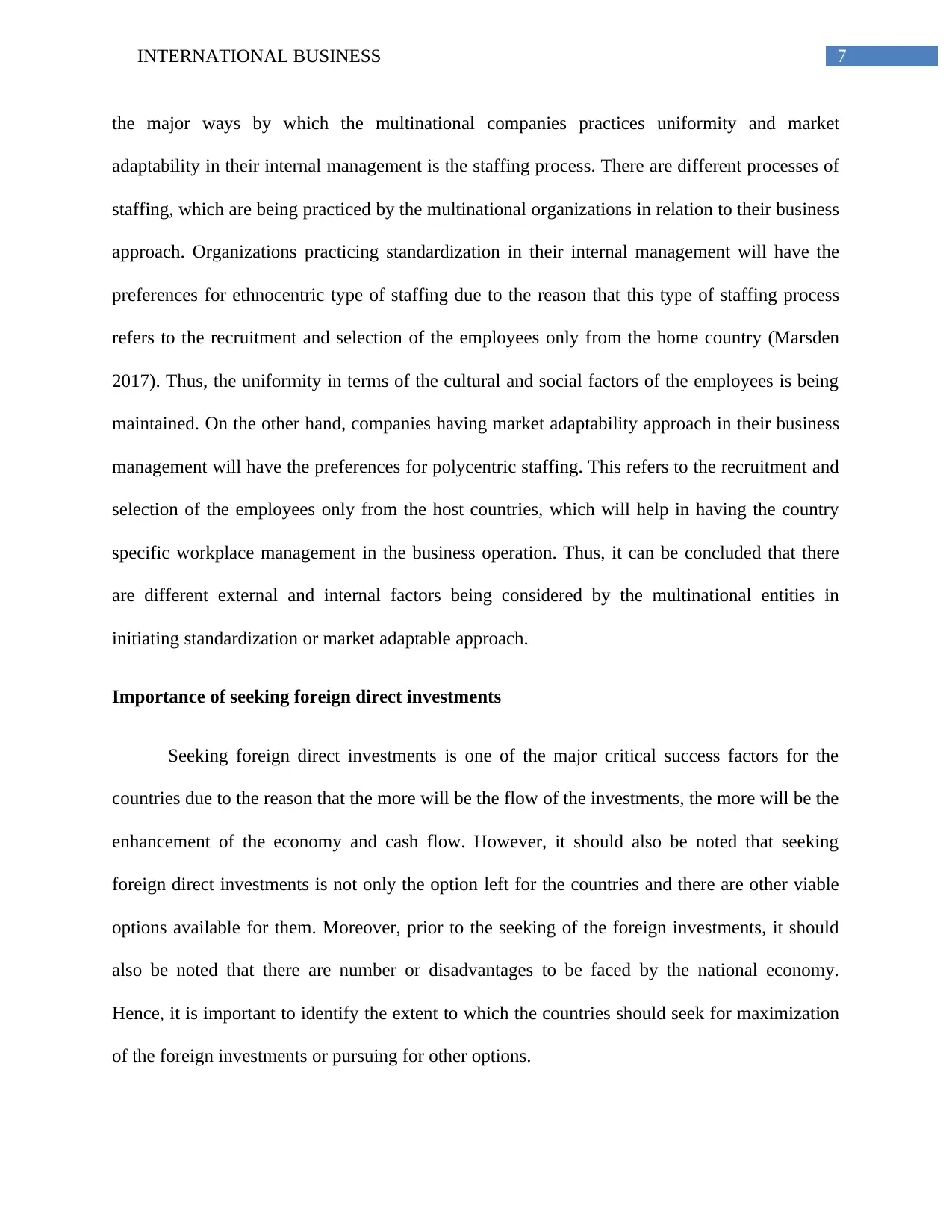
7INTERNATIONAL BUSINESS
the major ways by which the multinational companies practices uniformity and market
adaptability in their internal management is the staffing process. There are different processes of
staffing, which are being practiced by the multinational organizations in relation to their business
approach. Organizations practicing standardization in their internal management will have the
preferences for ethnocentric type of staffing due to the reason that this type of staffing process
refers to the recruitment and selection of the employees only from the home country (Marsden
2017). Thus, the uniformity in terms of the cultural and social factors of the employees is being
maintained. On the other hand, companies having market adaptability approach in their business
management will have the preferences for polycentric staffing. This refers to the recruitment and
selection of the employees only from the host countries, which will help in having the country
specific workplace management in the business operation. Thus, it can be concluded that there
are different external and internal factors being considered by the multinational entities in
initiating standardization or market adaptable approach.
Importance of seeking foreign direct investments
Seeking foreign direct investments is one of the major critical success factors for the
countries due to the reason that the more will be the flow of the investments, the more will be the
enhancement of the economy and cash flow. However, it should also be noted that seeking
foreign direct investments is not only the option left for the countries and there are other viable
options available for them. Moreover, prior to the seeking of the foreign investments, it should
also be noted that there are number or disadvantages to be faced by the national economy.
Hence, it is important to identify the extent to which the countries should seek for maximization
of the foreign investments or pursuing for other options.
the major ways by which the multinational companies practices uniformity and market
adaptability in their internal management is the staffing process. There are different processes of
staffing, which are being practiced by the multinational organizations in relation to their business
approach. Organizations practicing standardization in their internal management will have the
preferences for ethnocentric type of staffing due to the reason that this type of staffing process
refers to the recruitment and selection of the employees only from the home country (Marsden
2017). Thus, the uniformity in terms of the cultural and social factors of the employees is being
maintained. On the other hand, companies having market adaptability approach in their business
management will have the preferences for polycentric staffing. This refers to the recruitment and
selection of the employees only from the host countries, which will help in having the country
specific workplace management in the business operation. Thus, it can be concluded that there
are different external and internal factors being considered by the multinational entities in
initiating standardization or market adaptable approach.
Importance of seeking foreign direct investments
Seeking foreign direct investments is one of the major critical success factors for the
countries due to the reason that the more will be the flow of the investments, the more will be the
enhancement of the economy and cash flow. However, it should also be noted that seeking
foreign direct investments is not only the option left for the countries and there are other viable
options available for them. Moreover, prior to the seeking of the foreign investments, it should
also be noted that there are number or disadvantages to be faced by the national economy.
Hence, it is important to identify the extent to which the countries should seek for maximization
of the foreign investments or pursuing for other options.
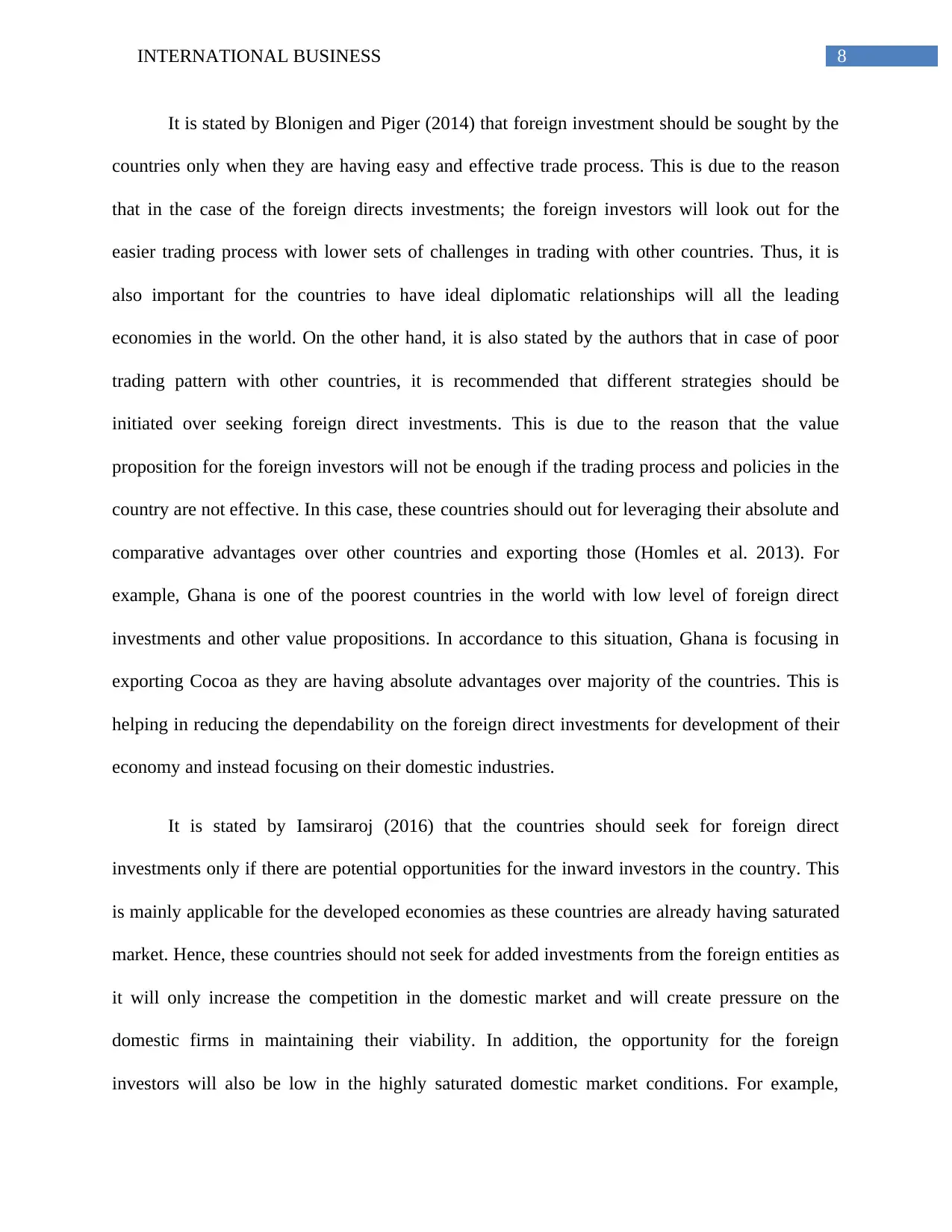
8INTERNATIONAL BUSINESS
It is stated by Blonigen and Piger (2014) that foreign investment should be sought by the
countries only when they are having easy and effective trade process. This is due to the reason
that in the case of the foreign directs investments; the foreign investors will look out for the
easier trading process with lower sets of challenges in trading with other countries. Thus, it is
also important for the countries to have ideal diplomatic relationships will all the leading
economies in the world. On the other hand, it is also stated by the authors that in case of poor
trading pattern with other countries, it is recommended that different strategies should be
initiated over seeking foreign direct investments. This is due to the reason that the value
proposition for the foreign investors will not be enough if the trading process and policies in the
country are not effective. In this case, these countries should out for leveraging their absolute and
comparative advantages over other countries and exporting those (Homles et al. 2013). For
example, Ghana is one of the poorest countries in the world with low level of foreign direct
investments and other value propositions. In accordance to this situation, Ghana is focusing in
exporting Cocoa as they are having absolute advantages over majority of the countries. This is
helping in reducing the dependability on the foreign direct investments for development of their
economy and instead focusing on their domestic industries.
It is stated by Iamsiraroj (2016) that the countries should seek for foreign direct
investments only if there are potential opportunities for the inward investors in the country. This
is mainly applicable for the developed economies as these countries are already having saturated
market. Hence, these countries should not seek for added investments from the foreign entities as
it will only increase the competition in the domestic market and will create pressure on the
domestic firms in maintaining their viability. In addition, the opportunity for the foreign
investors will also be low in the highly saturated domestic market conditions. For example,
It is stated by Blonigen and Piger (2014) that foreign investment should be sought by the
countries only when they are having easy and effective trade process. This is due to the reason
that in the case of the foreign directs investments; the foreign investors will look out for the
easier trading process with lower sets of challenges in trading with other countries. Thus, it is
also important for the countries to have ideal diplomatic relationships will all the leading
economies in the world. On the other hand, it is also stated by the authors that in case of poor
trading pattern with other countries, it is recommended that different strategies should be
initiated over seeking foreign direct investments. This is due to the reason that the value
proposition for the foreign investors will not be enough if the trading process and policies in the
country are not effective. In this case, these countries should out for leveraging their absolute and
comparative advantages over other countries and exporting those (Homles et al. 2013). For
example, Ghana is one of the poorest countries in the world with low level of foreign direct
investments and other value propositions. In accordance to this situation, Ghana is focusing in
exporting Cocoa as they are having absolute advantages over majority of the countries. This is
helping in reducing the dependability on the foreign direct investments for development of their
economy and instead focusing on their domestic industries.
It is stated by Iamsiraroj (2016) that the countries should seek for foreign direct
investments only if there are potential opportunities for the inward investors in the country. This
is mainly applicable for the developed economies as these countries are already having saturated
market. Hence, these countries should not seek for added investments from the foreign entities as
it will only increase the competition in the domestic market and will create pressure on the
domestic firms in maintaining their viability. In addition, the opportunity for the foreign
investors will also be low in the highly saturated domestic market conditions. For example,
⊘ This is a preview!⊘
Do you want full access?
Subscribe today to unlock all pages.

Trusted by 1+ million students worldwide
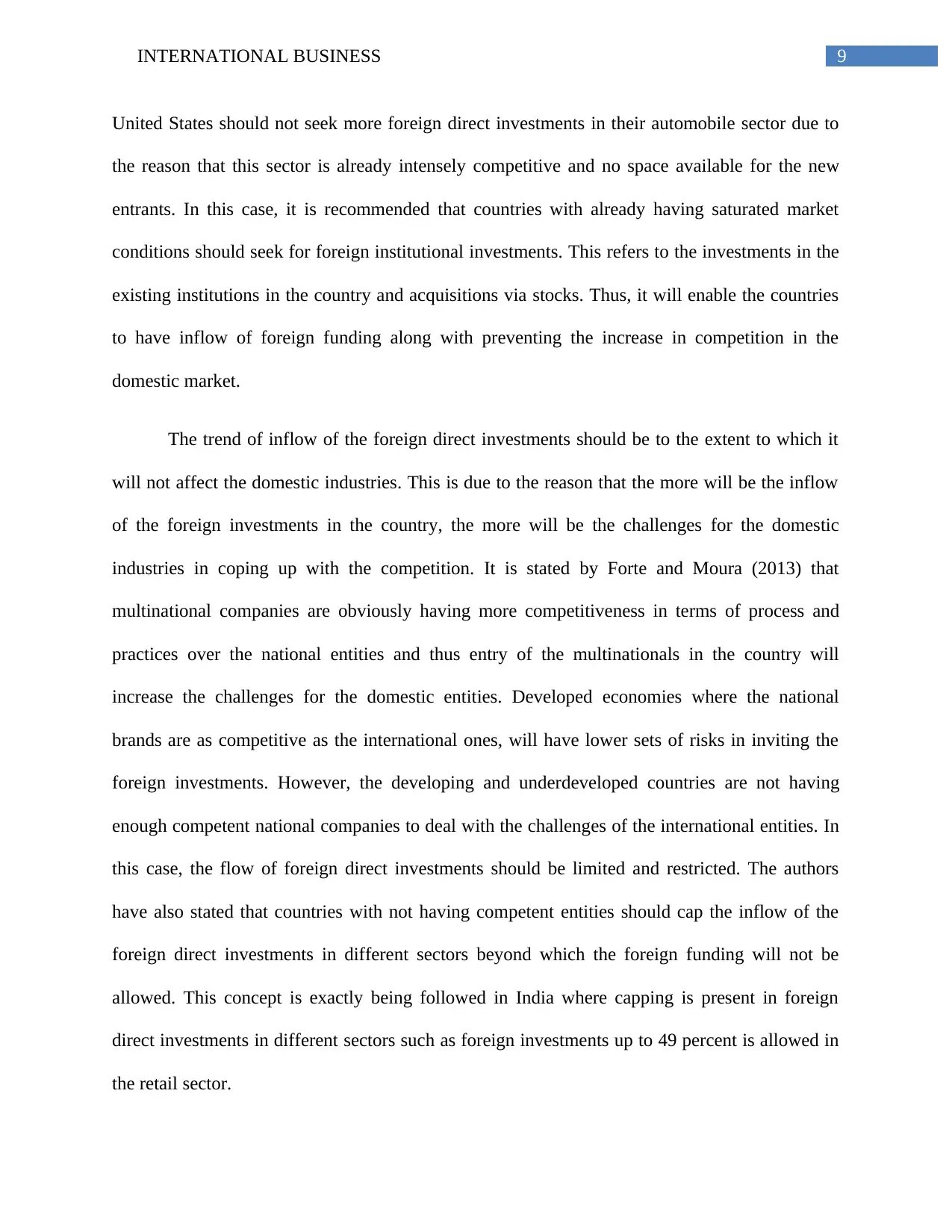
9INTERNATIONAL BUSINESS
United States should not seek more foreign direct investments in their automobile sector due to
the reason that this sector is already intensely competitive and no space available for the new
entrants. In this case, it is recommended that countries with already having saturated market
conditions should seek for foreign institutional investments. This refers to the investments in the
existing institutions in the country and acquisitions via stocks. Thus, it will enable the countries
to have inflow of foreign funding along with preventing the increase in competition in the
domestic market.
The trend of inflow of the foreign direct investments should be to the extent to which it
will not affect the domestic industries. This is due to the reason that the more will be the inflow
of the foreign investments in the country, the more will be the challenges for the domestic
industries in coping up with the competition. It is stated by Forte and Moura (2013) that
multinational companies are obviously having more competitiveness in terms of process and
practices over the national entities and thus entry of the multinationals in the country will
increase the challenges for the domestic entities. Developed economies where the national
brands are as competitive as the international ones, will have lower sets of risks in inviting the
foreign investments. However, the developing and underdeveloped countries are not having
enough competent national companies to deal with the challenges of the international entities. In
this case, the flow of foreign direct investments should be limited and restricted. The authors
have also stated that countries with not having competent entities should cap the inflow of the
foreign direct investments in different sectors beyond which the foreign funding will not be
allowed. This concept is exactly being followed in India where capping is present in foreign
direct investments in different sectors such as foreign investments up to 49 percent is allowed in
the retail sector.
United States should not seek more foreign direct investments in their automobile sector due to
the reason that this sector is already intensely competitive and no space available for the new
entrants. In this case, it is recommended that countries with already having saturated market
conditions should seek for foreign institutional investments. This refers to the investments in the
existing institutions in the country and acquisitions via stocks. Thus, it will enable the countries
to have inflow of foreign funding along with preventing the increase in competition in the
domestic market.
The trend of inflow of the foreign direct investments should be to the extent to which it
will not affect the domestic industries. This is due to the reason that the more will be the inflow
of the foreign investments in the country, the more will be the challenges for the domestic
industries in coping up with the competition. It is stated by Forte and Moura (2013) that
multinational companies are obviously having more competitiveness in terms of process and
practices over the national entities and thus entry of the multinationals in the country will
increase the challenges for the domestic entities. Developed economies where the national
brands are as competitive as the international ones, will have lower sets of risks in inviting the
foreign investments. However, the developing and underdeveloped countries are not having
enough competent national companies to deal with the challenges of the international entities. In
this case, the flow of foreign direct investments should be limited and restricted. The authors
have also stated that countries with not having competent entities should cap the inflow of the
foreign direct investments in different sectors beyond which the foreign funding will not be
allowed. This concept is exactly being followed in India where capping is present in foreign
direct investments in different sectors such as foreign investments up to 49 percent is allowed in
the retail sector.
Paraphrase This Document
Need a fresh take? Get an instant paraphrase of this document with our AI Paraphraser
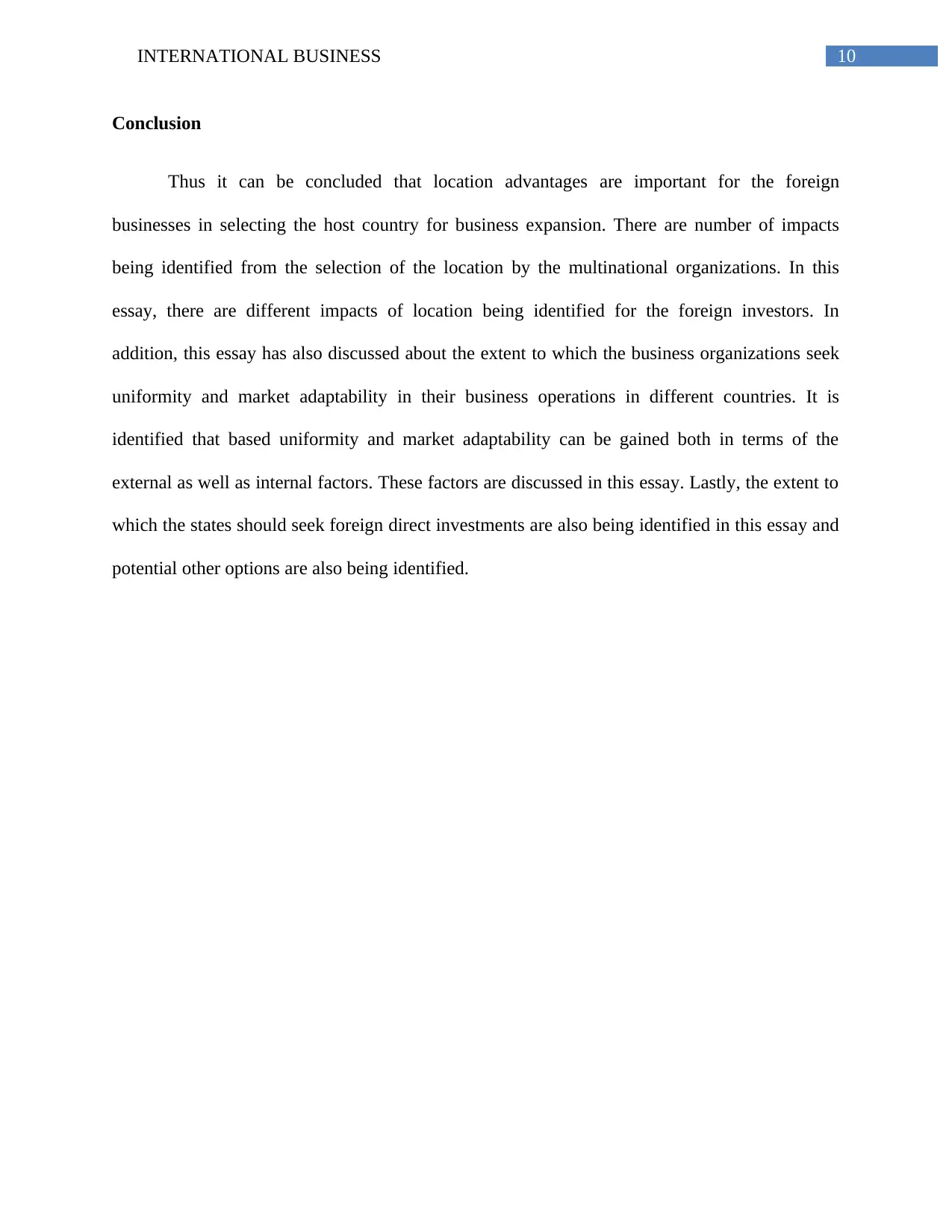
10INTERNATIONAL BUSINESS
Conclusion
Thus it can be concluded that location advantages are important for the foreign
businesses in selecting the host country for business expansion. There are number of impacts
being identified from the selection of the location by the multinational organizations. In this
essay, there are different impacts of location being identified for the foreign investors. In
addition, this essay has also discussed about the extent to which the business organizations seek
uniformity and market adaptability in their business operations in different countries. It is
identified that based uniformity and market adaptability can be gained both in terms of the
external as well as internal factors. These factors are discussed in this essay. Lastly, the extent to
which the states should seek foreign direct investments are also being identified in this essay and
potential other options are also being identified.
Conclusion
Thus it can be concluded that location advantages are important for the foreign
businesses in selecting the host country for business expansion. There are number of impacts
being identified from the selection of the location by the multinational organizations. In this
essay, there are different impacts of location being identified for the foreign investors. In
addition, this essay has also discussed about the extent to which the business organizations seek
uniformity and market adaptability in their business operations in different countries. It is
identified that based uniformity and market adaptability can be gained both in terms of the
external as well as internal factors. These factors are discussed in this essay. Lastly, the extent to
which the states should seek foreign direct investments are also being identified in this essay and
potential other options are also being identified.
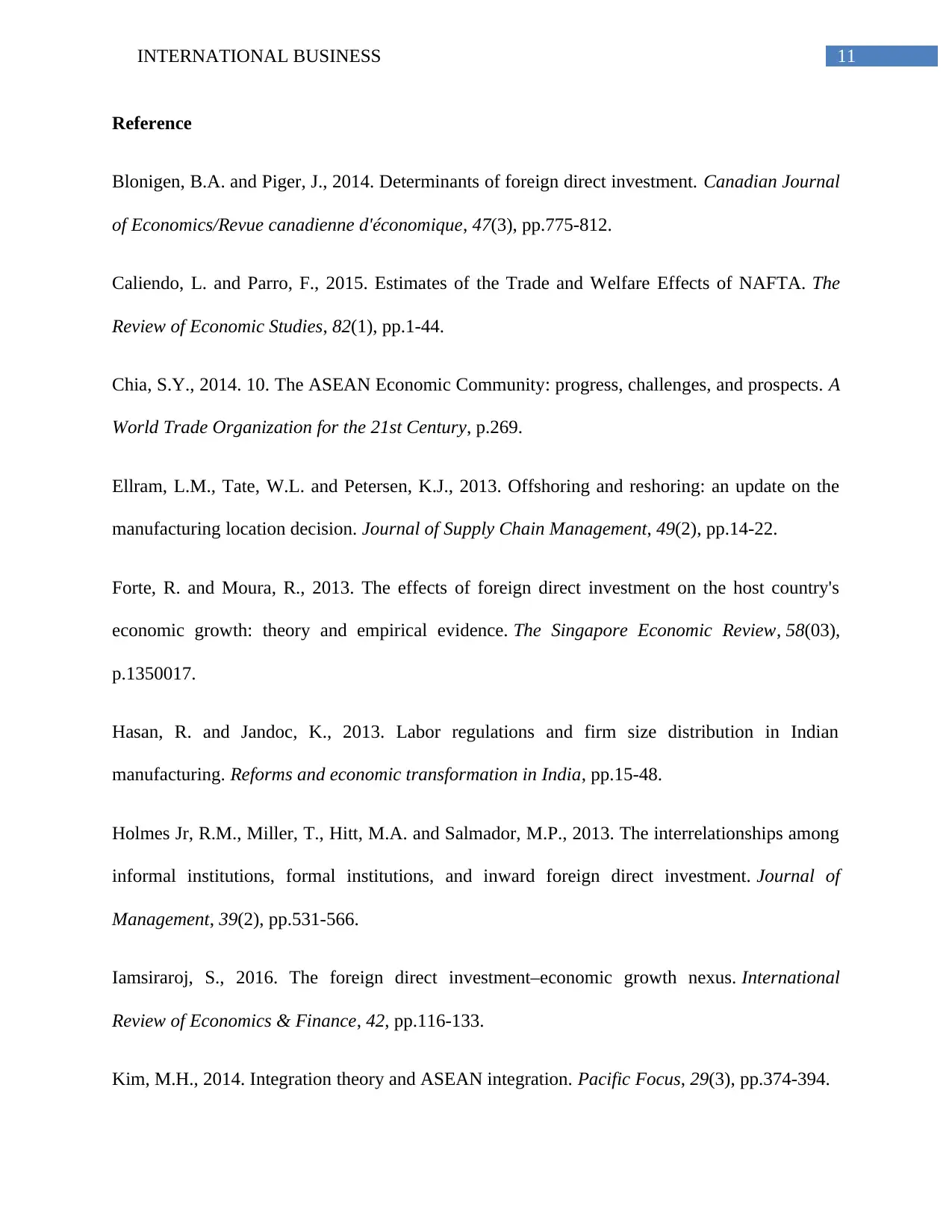
11INTERNATIONAL BUSINESS
Reference
Blonigen, B.A. and Piger, J., 2014. Determinants of foreign direct investment. Canadian Journal
of Economics/Revue canadienne d'économique, 47(3), pp.775-812.
Caliendo, L. and Parro, F., 2015. Estimates of the Trade and Welfare Effects of NAFTA. The
Review of Economic Studies, 82(1), pp.1-44.
Chia, S.Y., 2014. 10. The ASEAN Economic Community: progress, challenges, and prospects. A
World Trade Organization for the 21st Century, p.269.
Ellram, L.M., Tate, W.L. and Petersen, K.J., 2013. Offshoring and reshoring: an update on the
manufacturing location decision. Journal of Supply Chain Management, 49(2), pp.14-22.
Forte, R. and Moura, R., 2013. The effects of foreign direct investment on the host country's
economic growth: theory and empirical evidence. The Singapore Economic Review, 58(03),
p.1350017.
Hasan, R. and Jandoc, K., 2013. Labor regulations and firm size distribution in Indian
manufacturing. Reforms and economic transformation in India, pp.15-48.
Holmes Jr, R.M., Miller, T., Hitt, M.A. and Salmador, M.P., 2013. The interrelationships among
informal institutions, formal institutions, and inward foreign direct investment. Journal of
Management, 39(2), pp.531-566.
Iamsiraroj, S., 2016. The foreign direct investment–economic growth nexus. International
Review of Economics & Finance, 42, pp.116-133.
Kim, M.H., 2014. Integration theory and ASEAN integration. Pacific Focus, 29(3), pp.374-394.
Reference
Blonigen, B.A. and Piger, J., 2014. Determinants of foreign direct investment. Canadian Journal
of Economics/Revue canadienne d'économique, 47(3), pp.775-812.
Caliendo, L. and Parro, F., 2015. Estimates of the Trade and Welfare Effects of NAFTA. The
Review of Economic Studies, 82(1), pp.1-44.
Chia, S.Y., 2014. 10. The ASEAN Economic Community: progress, challenges, and prospects. A
World Trade Organization for the 21st Century, p.269.
Ellram, L.M., Tate, W.L. and Petersen, K.J., 2013. Offshoring and reshoring: an update on the
manufacturing location decision. Journal of Supply Chain Management, 49(2), pp.14-22.
Forte, R. and Moura, R., 2013. The effects of foreign direct investment on the host country's
economic growth: theory and empirical evidence. The Singapore Economic Review, 58(03),
p.1350017.
Hasan, R. and Jandoc, K., 2013. Labor regulations and firm size distribution in Indian
manufacturing. Reforms and economic transformation in India, pp.15-48.
Holmes Jr, R.M., Miller, T., Hitt, M.A. and Salmador, M.P., 2013. The interrelationships among
informal institutions, formal institutions, and inward foreign direct investment. Journal of
Management, 39(2), pp.531-566.
Iamsiraroj, S., 2016. The foreign direct investment–economic growth nexus. International
Review of Economics & Finance, 42, pp.116-133.
Kim, M.H., 2014. Integration theory and ASEAN integration. Pacific Focus, 29(3), pp.374-394.
⊘ This is a preview!⊘
Do you want full access?
Subscribe today to unlock all pages.

Trusted by 1+ million students worldwide
1 out of 14
Related Documents
Your All-in-One AI-Powered Toolkit for Academic Success.
+13062052269
info@desklib.com
Available 24*7 on WhatsApp / Email
![[object Object]](/_next/static/media/star-bottom.7253800d.svg)
Unlock your academic potential
Copyright © 2020–2025 A2Z Services. All Rights Reserved. Developed and managed by ZUCOL.





